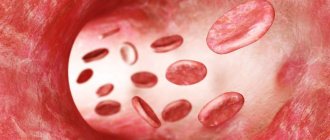Description of the analysis
Determination of mchc occurs through calculations based on basic data, such as hematocrit, obtained from a complete blood count. This index serves as a highly sensitive test for disruption of hemoglobin generation processes. The main advantage is that it is independent of the average volume of red blood cells.
Essentially mchc reflects the density of filling red blood cells with hemoglobin and is a very stable indicator. Therefore, mchc is often used as an indicator of errors in the operation of laboratory equipment. But do not confuse MCHC with MCV, as these are different indicators.
HGB (Hb, hemoglobin) – hemoglobin concentration
Most accurate method
Mindray systems use the cyanide-free methemoglobin method using imidazole as the ligand. The method is fast (10 seconds) and sensitive, much less affected by high levels of leukocytes in the blood than hemiglobin cyanide. The reagent (NaOH and lauramine oxide) dissolves all cellular particles and lipids and destroys bilirubin - thus eliminating interference due to hemoglobin turbidity. Therefore, this method provides more reportable results than any other.
False indicators
| The indicator may be overestimated as a result of: |
|
Clinical and diagnostic value
| An increase in hemoglobin concentration is observed when: | A decrease in hemoglobin concentration occurs when: |
|
|
Preparing for analysis
Direct analyzes for mchc are not done; general analysis data (CCA) are used for calculations. To carry it out, blood is taken from a vein, the amount is up to 3 ml. If certain indicators are present, it is possible to take capillary blood; such an analysis is prescribed for children under 3 years of age, patients with pathologies of the blood coagulation system.
No special preparation is required for a general blood test. Blood sampling is performed in the morning, on an empty stomach, or at any convenient time of the day. The main condition is not to eat for at least 8 hours before the test. You can drink water, but not coffee, tea or sweet drinks.
To increase the reliability of the data obtained, it is recommended to avoid stress, excessive physical and psycho-emotional stress 1-2 days before blood collection. You should avoid drinking alcohol.
How to prepare for the test
To obtain the most reliable data, it is recommended to carry out a number of preparatory activities. They will help not to “blur” the overall picture and accurately diagnose any deviation from the norm. Before taking blood, you must refrain from eating at least 4 hours before the procedure. It is also recommended to exclude heavy physical activity, emotional disorders and stress the day before. When taking any medications, you should talk in advance with your doctor, who can evaluate their composition and understand whether taking them can affect the analysis. If medications affect the results, you will need to limit their use a few days before the test. You also need to stop drinking alcoholic beverages and drugs. To achieve reliability, it is better not to smoke before analysis.
The best option is to visit the laboratory in the morning, on an empty stomach. In the morning you are allowed to drink only a glass of clean water. Strong tea, coffee and any other snack are not allowed. If it is necessary to donate blood several times to monitor therapy or more detailed diagnostics, then it is best to do this at the same time and in a similar condition. It is also worth contacting an identical clinic or laboratory. By adhering to these rules, the influence of third-party factors on the results obtained will be reduced to almost zero.
MCHC blood test explanation
A normal mchc value is considered to be between 310 and 380 g/l. Such values are considered the norm for adults of both sexes. In newborns, children, and adolescents, the normal limits are shifted downward. For children under 1 year of age, the average amount of hemoglobin in a red blood cell is considered to be 290-370 g/l.
After the completion of puberty, the normal concentration of iron-containing proteins stabilizes and remains throughout life within certain limits (in the absence of pathologies that can affect this indicator).
It is important to consider that finding the mchc index in the range of normal values does not always mean the absence of pathologies. There are anemia and other diseases that do not manifest themselves as a change in the mchc level in a blood test.
Application of the red blood cell index
The red blood cell index is quite common in blood tests. It is used to detect inaccuracies made during research. The MCHC red blood cell index is used to assess the effectiveness of anemia treatment, diagnose hypochromia, etc.
Iron deficiency anemia is a pathology that often appears in our century. It is caused by the fact that a small amount of iron comes with food, or it is not completely absorbed in the digestive system.
Manifestation of iron deficiency anemia
Certain chronic diseases, along with blood loss, can also cause this pathology. The popular name for this “sore” is anemia. Its characteristic feature is a low level of red blood cells, which occurs due to the fact that red blood cells are either quickly destroyed or slowly formed, and of course, let’s not forget about severe bleeding. To identify anemia, it is not enough just to determine the level of hemoglobin and red blood cells.
The standard procedure, to determine a more accurate state of affairs, includes the study of such blood parameters as:
- MCHC (intermediate hemoglobin concentration);
- MCH (intermediate hemoglobin content in 1 red blood cell);
- MCV (intermediate erythrocyte volume);
- RDW (red blood cell distribution width by volume).
MCHC in blood test is increased
A high mchc index occurs when the concentration of iron-containing proteins in red blood cells increases. Such conditions are usually observed in various genetic pathologies. The most common:
- Hereditary spherocytosis. This is a disease in which the formation of the erythrocyte cytoskeleton is disrupted. As a result, the surface area of the cell membrane decreases, its plasticity is disrupted, and the concentration of hemoglobin in the cell increases significantly. You can find out about the analysis of hemoglobin levels here. Spherocytosis often occurs in hidden, benign forms and is detected only during screening diagnostics.
- Sickle cell anemia. One of the most common congenital diseases of red blood cells. As a result of disturbances in the process of hemoglobin production, red blood cells acquire a changed shape, and the mchc index increases. In such patients, hemoglobin has a different structure from the norm and carries oxygen less efficiently. If pathological genes are passed on from one of the parents, the disease occurs in a latent or mild form and provides immunity from malaria. When receiving defective genes from the mother and father, sickle cell anemia is severe and can cause serious pathologies and death.
- Hemoglobinosis C. A severe hereditary pathology that develops when both parents receive defective genes that direct the synthesis of erythrocyte proteins. Manifests itself in the form of hemolytic jaundice, chronic anemia, the most common complication is cholelithiasis. Defective hemoglobin is produced by the body in significant quantities because it carries oxygen worse than normal protein. As a result, a sharp increase in mchc index values is observed.
An increase in the mchc index does not always serve as a signal for the development of pathological processes. This figure may increase as the body recovers after severe blood loss. For residents of high mountains, an increase in hemoglobin concentration is a normal option as it serves to compensate for the low oxygen content in the air.
Therefore, professional climbers may experience a significant increase in the mchc index, which, in the absence of other pathological symptoms, should be assessed as normal.
Causes of low average hemoglobin concentration in erythrocytes
If the existing indicators deviate from the norm (with a significant decrease), we can talk, for example, about a disease such as hypochromia, which develops as a result of insufficient absorption of contents such as hemoglobin by cells and blood cells.
This condition is often caused by a number of pathologies that exist in the human body, due to which the production of a blood element called hemoglobin is disrupted.
Reasons such as:
- Hypochromic anemia of sideroblastic and iron deficiency;
- Posthemorrhagic anemia with an existing chronic course of the disease;
- Hemaglobinopathies are disorders of the synthesis of the described particles;
- Disorders associated with insufficiency of metabolic water-electrolyte processes;
- Pathological conditions of genetic origin.
For any disorders associated with hemoglobin synthesis, indicators of reduced MSHC in the hematopoietic system are determined at the very end. And if during the examination the results of the index (Mchc) are lowered, but the blood cells themselves and the iron-containing element are normal, it is permissible to talk about an erroneous conduct of the current study.
MCHC reduced
Deciphering the mchc blood test when the index decreases is required much more often. In this case, the concentration of iron-containing protein in red blood cells decreases, often so significantly that with direct microscopy, red blood cells become much less saturated in color.
This phenomenon is called blood hypochromia, and anemia that is accompanied by a decrease in this index is called hypochromic. There are many reasons for a decrease in mchc in a blood test, the most common are:
- Iron-deficiency anemia. Occurs when there is a lack of foods enriched with iron in the diet, or a violation of its absorption in the intestines. It is often found among vegetarians, since large amounts of iron are found in easily digestible form in meat and other animal products.
- Thalassemia. A hereditary disease associated with the transmission to a child of inheritance of defective genes responsible for coding the protein chains of hemoglobin.
- Anemia, which serves as a symptom of the development of pathologies of the liver, bone marrow, kidneys and other organs.
Another specific condition for which decreased mchc levels are a marker is lead poisoning. This toxic metal is dangerous in any concentration; it is widely used in various industries, so the likelihood of poisoning with it is quite high. Acute forms of poisoning are extremely rare; in chronic forms, this toxic metal gradually accumulates in the bones, nerve tissues, and bone marrow.
The hematopoietic function is inhibited, pathologies of the nervous system develop, and the kidneys and liver suffer. There are practically no specific symptoms for such poisonings, so if a patient has a decrease in mchc, the possibility of intoxication with this metal must be taken into account. Our medical center employs the best specialists who can explain each of the tests, and we also have the best prices for services in the city of Minsk.
Necessary therapy for a low MNCH index
If a reduced level of concentration of iron-containing protein in such elements is detected, medical professionals prescribe therapeutic treatment using medications that can increase the level of MNCH.
Having determined the reasons for the decrease in MNCH levels, doctors develop an individual therapeutic treatment plan. The basis of this treatment are:
- A vitamin complex with an element of group “B” included in its composition;
- Mineral components and additives;
- Preparations rich in components such as folic acid and iron.
With the described deficiency of pigment in the cells, patients under 3 years of age are recommended to take drugs in the form of Ferum, Lek, Actifferin, while older children are advised to take drugs in the form of Totem, Ferroplex, Tardiferon. The purpose of these particular drugs is due to the content of natural elements in their composition, which during the treatment process in no way can harm the child’s still fragile body.
The treatment process for the adult generation is based on the same medications, but in a much higher dosage. The duration of the prescribed course of treatment varies from 1 to 3 months, and the frequency of administration and individual dosage is calculated by the attending doctor, taking into account all the characteristics of the body of a particular patient, as well as based on the reasons that led to this condition.
The above-described therapy is complemented by the inclusion in the patient’s daily menu of foods rich in elements in the form of iron and folic acid.










